Introducing early literacy skills
Editor
Posted 26 February 2015
The Shine Literacy project set out to create a collegial environment for new entrant teachers to work together to implement a ‘Language to Literacy’ strategy when introducing early literacy skills. This strategy was intended to be of equal value to children regardless of the way they approach learning to read and write and of their socio-economic background. In particular, the Project aimed to ensure that there was no increasing achievement gap (The Matthew Effect) with those entering school with a large amount of literacy knowledge making greater gains than those who entered school with less.
At the first re-assessment, after 16 weeks at school, these aims have been met. Children in the trial schools made greater progress (results were statistically significant) in all areas that were targeted in the teaching approach being trialled.
How the project started
The Shine Literacy Project began after a successful trial of the approach at Titahi Bay School between 2010 and 2102.
Percentage of Titahi Bay School students achieving at or above National Standards in 2012
|
|
Reading |
Writing |
|
Year 3*** |
79% |
91% |
|
Year 4** |
85% |
89% |
|
Year 5* |
62% |
71% |
|
Year 6 |
49% |
60% |
*** Three years of integrated literacy instruction – in Years 1-3
** Two years of integrated literacy instruction – in Years 2 & 3
* One year of integrated literacy instruction – in Year 3
On the basis of these results, the education researchers at the Institute of Education at Massey University designed a larger, more robust, study which was approved by the Massey Ethics Committee in March 2013.
The research project directly addressed community priorities identified at the Shine summit in June 2013. It attracted strong local support from teachers and from the Porirua Foundation which was essential to obtain the participation and funding required to begin in May 2014. Schools from the wider Wellington region willingly agreed to take part as comparison schools to provide a population size and balance between trial and comparison schools. Comparison schools have been invited to participate in the intervention from July 2015.
The Approach
We have used a combination of conducting professional learning seminars for teachers and providing classroom resources to make the teaching approach easy to implement.
Teachers have given up their own time to attend professional learning seminars after school. We had funding from the Ministry of Education for releasing teachers for a one-day training session on developing vocabulary knowledge. This was vastly better than working for short sessions at the end of a teaching day. Our goal is to find funding to allow future training sessions to be one-day sessions.
The approach used is teaching foundation literacy skills in an integrated way.
Core elements of the approach are:
- Teaching from sounds to words, and sounds to print – using children’s own language to learn about the alphabetic code –teaching from the known to the unknown.
- Teaching children how the alphabetic code really works – that letters are used to record sounds in lots of different ways – children are exposed to the concept of diversity from the outset (that /k/ can be a c in Cathy, k in Kyle, cc in Rocco, ck in Jack and ch in Christopher).
- Learning to write the code as a platform for learning to read it.
- Using the assessment data to track student progress and tailor instruction to meet learning needs
Student Achievement
We were aware of the typical patterns of reading achievement for children starting school with greater or lesser literacy knowledge. John Hattie provides graphs that represent these achievement patterns.

Pattern A depicts an increasing achievement gap – the Matthew effect.
Pattern B shows a decreasing achievement gap (compensatory model).
Pattern C indicates a stable achievement gap..
REF: Individual Differences in Reading Development: A Review of 25 Years of Empirical Research on Matthew Effects in Reading
Maximilian Pfost, John Hattie, Tobias Dörfler and Cordula Artelt
REVIEW OF EDUCATIONAL RESEARCH published online 15 November 2013
Our goal is to prevent the widening achievement gap and to engage teachers in the potential for closing the achievement gaps associated with socio-economic background
Testing regime
Children were assessed in their first 2-4 weeks at school then after 16-18 weeks at school. This was completed by mid-December 2014. Children will be reassessed after 37-38 weeks at school. This testing will be completed by the end of June 2015. There will be two more rounds of testing – at the end of 2015 and in mid-2016. If we have funding available we would also like to follow up the cohort of children at the end of Year 4.
We assessed:
Vocabulary knowledge* – as a baseline to show the knowledge children had at school entry. This focused on English words and concepts children would be likely to meet in our classrooms.
Knowledge of letter names – upper and lower case letters.
Being able to name each letter of the alphabet.
Clay Word Reading
Being able to read 15 high-frequency words correctly.
SPAT - Phonological awareness skills*
Children were assessed for their ability to hear syllables, detect and produce rhyme, identify initial and final sounds, blend sounds to make words, count sounds in words and delete sounds. These are critical skills for using the alphabetic code.
Knowledge of letter sounds *– uppercase and lower case letters
Being able to provide an appropriate sound for each letter of the alphabet.
Sound-letter knowledge*
Being able to write every sound of English.
Invented spelling*
Being able to write 18 words made up of most of the sounds of English.
* These skills were a strong focus of the teaching approach used by the Trial schools
Cohort Characteristics
Size
The cohort size is 259 children.
112 (43.2%) are boys and 147 (56.8%) are girls
Trial group size: 138 (71 Decile 9-0; 67 Decile 1-4)
Comparison Group size: 121 (69 Decile 10; 52 Decile 1-3)
Ethnicity
28 different ethnicities were recorded. These have been grouped into:
Pakeha 46.3%
Maori 21.2%
Pasifika 18.5%
Asian 11.6%
European 1.5%
Other 0.8%
Decile Ranking
1 19.7%
2 15.1%
3 7.3%
4 3.9%
9 3.9%
10 50.2%
Deciles by Ethnicity
Deciles 1 & 2
44.4% Pasifika
26.5% Maori
11.1% Pakeha
Decile 3 & 4
41.4% Pakeha
31.0% Maori
13.8% Pasifika
10.3% Asian
3.4% Other
Deciles 9 & 10
70% Pakeha
9.3% Maori
2.9% Pasifika
Results
British Picture Vocabulary Scale
There was no significant difference between the results for Comparison and Trial cohorts.
Comparison Group Mean: 98.64
Trial Group Mean: 99.75
There were significant differences comparing high and low decile groups in the Comparison and Trial cohorts:
Comparison High Group Mean: 103.96
Comparison Low Group Mean: 91.58
Trial High Group Mean: 106.23
Trial Low Group mean: 92.26
Letter Names: Upper Case /26
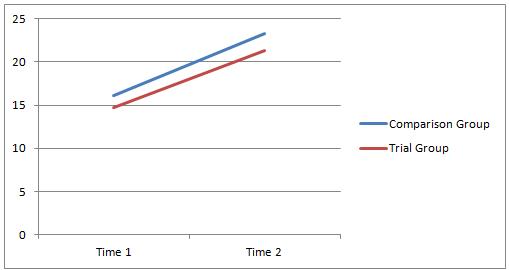
Mean scores
|
|
Comparison |
Trial |
Significance |
|
Time 1 |
16.12 |
14.70 |
Sig (comp) |
|
Time 2 |
23.27 |
21.36 |
Sig (comp) |
Letter Names: Lower Case /28

Mean scores
|
|
Comparison |
Trial |
Significance |
|
Time 1 |
15.17 |
13.37 |
Non Sig |
|
Time 2 |
23.80 |
21.84 |
Sig (comp) |
Clay Word Reading /15
Reading high-frequency words

Mean scores
|
|
Comparison |
Trial |
Significance |
|
Time 1 |
1.53 |
.92 |
Non sig |
|
Time 2 |
6.90 |
5.86 |
Non sig |
Sound to Letter /45
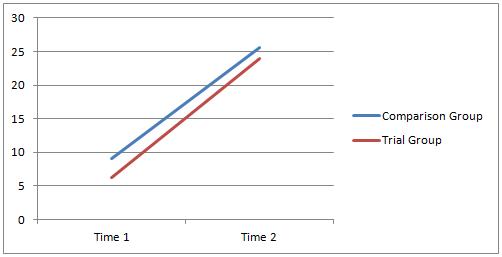
Mean scores
|
|
Comparison |
Trial |
Significance |
|
Time 1 |
9.13 |
6.29 |
Sig (comp) |
|
Time 2 |
25.60 |
24.02 |
Non Sig |
Letter Sounds: Upper Case /26

Mean scores
|
|
Comparison |
Trial |
Significance |
|
Time 1 |
11.45 |
7.50 |
Sig (comp) |
|
Time 2 |
19.58 |
18.48 |
Non Sig |
Letter Sounds: Upper Case - by Decile Groups

Progress by decile bands: Comparison High v Trial High, Comparison Low v Trial Low
|
|
Comparison High |
Trial High |
Significance |
|
Time 1 |
15.42 |
10.99 |
|
|
Time 2 |
23.27 |
21.23 |
|
|
|
Comparison Low |
Trial Low |
Significance |
|
Time 1 |
6.17 |
3.39 |
|
|
Time 2 |
14.58 |
15.38 |
|
Letter Sounds: Lower Case /28
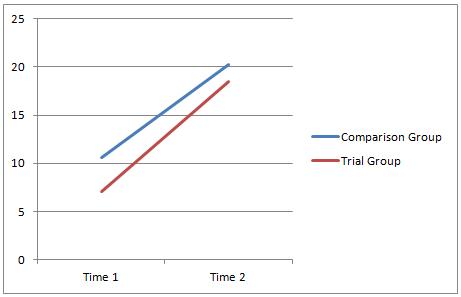
Mean scores
|
|
Comparison |
Trial |
Significance |
|
Time 1 |
10.65 |
7.05 |
Sig (comp) |
|
Time 2 |
20.22 |
18.48 |
Non Sig |
Letter Sounds: Lower Case –by Decile Group
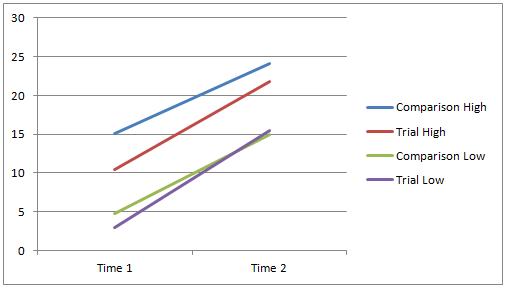
Progress by decile bands: Comparison High v Trial High, Comparison Low v Trial Low
|
|
Comparison High |
Trial High |
Significance |
|
Time 1 |
15.06 |
10.44 |
|
|
Time 2 |
24.08 |
21.85 |
|
|
|
Comparison Low |
Trial Low |
Significance |
|
Time 1 |
4.81 |
3.04 |
|
|
Time 2 |
15.00 |
15.45 |
|
Invented Spelling /54
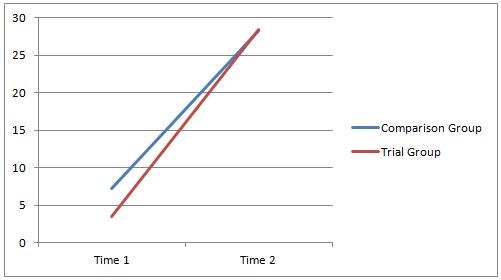
Mean scores
|
|
Comparison |
Trial |
Significance |
|
Time 1 |
7.28 |
3.54 |
Sig |
|
Time 2 |
28.33 |
28.49 |
Non sig |
Invented Spelling – by Decile Groups

Progress by decile bands: Comparison High v Trial High, Comparison Low v Trial Low
|
|
Comparison High |
Trial High |
Significance |
|
Time 1 |
11.17 |
5.61 |
Sig |
|
Time 2 |
34.59 |
32.61 |
Non sig |
|
|
Comparison Low |
Trial Low |
Significance |
|
Time 1 |
2.16 |
1.18 |
Non sig |
|
Time 2 |
19.86 |
24.56 |
Sig (Trial) |
SPAT: Sutherland Phonological Awareness Test
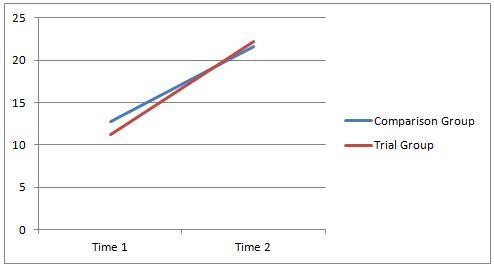
Mean scores
|
|
Comparison |
Trial |
Significance |
|
Time 1 |
12.75 |
11.23 |
Non Sig |
|
Time 2 |
21.62 |
22.17 |
Non sig |
SPAT: Sutherland Phonological Awareness Test - by Decile Groups
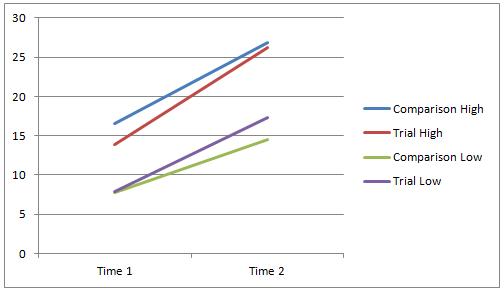
Progress by decile bands: Comparison High v Trial High, Comparison Low v Trial Low
|
|
Comparison High |
Trial High |
Significance |
|
Time 1 |
16.61 |
13.94 |
Non Sig |
|
Time 2 |
26.89 |
26.23 |
Non Sig |
|
|
Comparison Low |
Trial Low |
Significance |
|
Time 1 |
7.78 |
7.96 |
Non sig |
|
Time 2 |
14.49 |
17.31 |
Borderline sig(Trial) |
Ongoing funding for the Project
We have to continue to fundraise for the costs associated with running this project. We are launching a page on the Spark Foundation’s ‘Give a Little’ website (www.givealittle.co.nz) called ‘Literacy Success for All’. Please let your school community know about this and help us to continue.
Conclusion
This project is based on robust data collection, critical analysis of the results and careful consideration of the findings. We are grateful to John Cody from Shine for helping to get this project started and for his ongoing support; to the schools, teachers, children and their families who are part of the project; to the Massey University researchers for their research expertise and support; to Whitireia Polytechnic for providing us with a base to work from; to the funders who have made it possible for us to undertake this project.
Thanks to these organisations who have provided funding:
Infinity Foundation, Pub Charities, Porirua Foundation, Mana Community Grants Foundation,
TG McCarthy Trust
